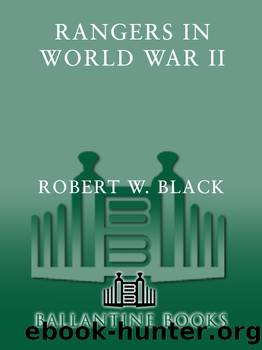Rangers in World War II by Robert W. Black

Author:Robert W. Black [Black, Robert W.]
Language: eng
Format: epub
ISBN: 978-0-307-77615-0
Publisher: Random House Publishing Group
Published: 2010-11-09T16:00:00+00:00
Despite the slaughter on Omaha Charlie, succeeding waves of infantry and engineers had continued to land. Men of the 146th, 149th, and 121st Engineers valiantly tried to clear paths through the obstacles and were shot down in large numbers. Coming in behind Company A of the 116th and Company C of the 2d Rangers, the men of B and D Companies of the 116th Infantry were gunned down as the ramps dropped. The situation was chaos, compounded by fire-induced shock. While some men struggled to fight, others tried vainly to hide in the water or behind any object that seemed to offer protection.
Seeing the carnage of Omaha Charlie Beach, Colonel Schneider observed that Omaha Dog White to the left of Charlie was comparatively quiet. By hand and arm signals, Schneider ordered the remainder of his flotilla to steer to a landing point on the left of the carnage.
This change of direction by Colonel Schneider was one of the key tactical decisions of the invasion. It would place the right unit at the right place at the right time. The point of landing for Force C now included the left edge of Omaha Charlie Beach and Omaha Dog White.
The LCAs carrying the men of A, B, and some headquarters personnel of the 2d Ranger Battalion were on the right. For these men, the point of landing was on the attackers’ left portion of Omaha Charlie approximately one thousand yards east of the beach exit.
The first wave consisted of six LCAs. From left to right these were: Two craft carrying Company A, 2d Rangers, the Ranger Group headquarters LCA, a 2d Ranger Battalion headquarters LCA, and two Company B, 2d Ranger Battalion, LCAs. Ramps went down at 0740, and the killing commenced.
The LCA carrying the 2d Platoon of B Company, 2d Rangers, hit a mine that blew off the bow landing ramp. Lieutenant Fitzsimmons was knocked unconscious by the explosion. The 2d Platoon LCA sank, throwing most of the men into deep water, most of whom made it to shore but lost their weapons and equipment. The 1st Platoon boat dropped its ramp, and the men started ashore. Lt. Robert Brice of the 1st Platoon of B Company was killed as he signaled his men forward. M. Sgt. Robert Lemin, the 2d Battalion sergeant major, was also killed. The Germans fired directly into the landing craft as the ramps dropped, then increased the enfilade fire of automatic weapons as the men reached shore.
Somehow the surviving Rangers continued to struggle inland. Captain Rafferty, company commander, and 1st Sgt. Edward Sowa of Company A 2d Rangers were both killed. Ranger Clyde Pattison took a burst of machine-gun fire through his right arm, ripping it to the consistency of hamburger. Pattison kept going and made it across the beach. The few surviving medics were busy elsewhere, so Pattison bandaged his own wounds; it would be three days before he reached a hospital.
With every minute, the number of casualties increased. Ranger chaplain Joseph Lacy roamed the beach, binding wounds and comforting the dying.
Download
This site does not store any files on its server. We only index and link to content provided by other sites. Please contact the content providers to delete copyright contents if any and email us, we'll remove relevant links or contents immediately.
| Afghan & Iraq Wars | American Civil War |
| American Revolution | Vietnam War |
| World War I | World War II |
Waking Up in Heaven: A True Story of Brokenness, Heaven, and Life Again by McVea Crystal & Tresniowski Alex(37003)
Empire of the Sikhs by Patwant Singh(22172)
We're Going to Need More Wine by Gabrielle Union(18072)
Hans Sturm: A Soldier's Odyssey on the Eastern Front by Gordon Williamson(16625)
Leonardo da Vinci by Walter Isaacson(11902)
The Radium Girls by Kate Moore(10907)
Educated by Tara Westover(7061)
Tools of Titans by Timothy Ferriss(6946)
How to Be a Bawse: A Guide to Conquering Life by Lilly Singh(6693)
The Last Black Unicorn by Tiffany Haddish(5075)
Permanent Record by Edward Snowden(4997)
The Rise and Fall of Senator Joe McCarthy by James Cross Giblin(4843)
Promise Me, Dad by Joe Biden(4447)
The Wind in My Hair by Masih Alinejad(4424)
The Crown by Robert Lacey(4105)
A Higher Loyalty: Truth, Lies, and Leadership by James Comey(4032)
The Iron Duke by The Iron Duke(3639)
Joan of Arc by Mary Gordon(3258)
How to be Champion: My Autobiography by Sarah Millican(3186)
